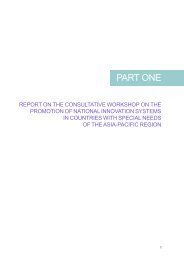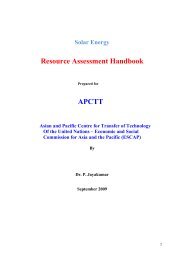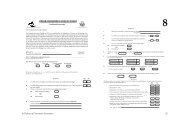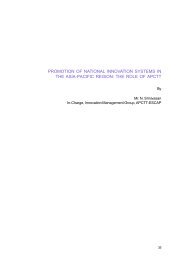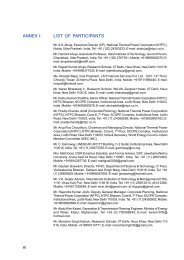Download Complete PDF - apctt
Download Complete PDF - apctt
Download Complete PDF - apctt
- No tags were found...
Create successful ePaper yourself
Turn your PDF publications into a flip-book with our unique Google optimized e-Paper software.
Figure 1-5: Strategy for commercially competitive coal-fired power plantsProliferation of clean coal technologies - Multiple dimensionsAcademia-Industry-GovernmentIntensive research &technology-drivenproof of conceptsIndustry-GovernmentCritical demonstrationplants for differentgeographical settings80:20 funding bygovernment andindustryNew clean coal power generation technologiesNational CleanEnergy Fundmust focuson criticaldevelopmentsR&D stageCost: Rs 180 mil/MWEarly developmentCost: Rs 120 mil/MWIndustry-GovernmentMass-scale deploymentin tandem with manufacturingcapacity creationGovernmentPolloy supportPAT, Carbon indexTargetCost: Rs 70 mil/MWthe Indian scenario on coal, oil and gas from both short-term and long-term perspectives.Fossil power generation technologies involve gas turbines, steam turbines and gasifiers.Combined cycle efficiencies of gas turbines are increasing over the years, as firingtemperatures are increased. He explained GE’s advanced gas turbine, steam turbineand combustion technologies.Mr. Gali said that CO 2reduction alternatives in the power sector involve:• Alteration of system operations;• Addition of new generation options;• Replacement or modification of existing system; and/or• Alteration of electrical consumption pattern.Modification of existing system may involve steam turbine retrofit that results in improvedefficiency, reduced CO 2and reduced cost per unit electricity produced. In conclusion,Mr. Gali said:• Technology to address climate change and efficiency improvement exists;• A portfolio of technology solutions should be pursued; and• Deployment often requires policy support, incentives and mandates.Mr. Gali’s presentation is given in Annex VII.Mr. A.K. Sinha, General Manager (PE), NTPC, presented a “SWOT Analysis of FossilFuel Technology”. He quoted IEA’s projections for 2035 as:• Rising fossil energy use will lead to irreversible and potentially catastrophic climatechange;• Global energy-related CO 2emissions peak before 2020 and then decline to 21.6Gt by 2035;• Carbon capture and storage (CCS) is a likely abatement option (efficacy yet to beproven), accounting for 18 per cent of emissions savings;14



